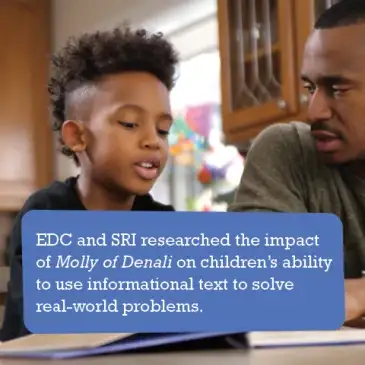
Molly of Denali is a popular new PBS KIDS series focused on informational text.
You’ve probably seen studies showing that high-quality media can teach children new information. Two new studies from EDC and SRI Education tell us something more: Well-designed media can also teach children how to get information.
To succeed in school and life, children need to know how to get information, whether it’s reading a map, watching a how-to video, looking something up in an index, or identifying a trustworthy news article. These are examples of informational text-oral, written, or visual text designed to inform. Young children need more opportunities to use and learn about informational text; they often have greater access to narrative stories than informational text both at home and at school.

That’s where a new PBS KIDS series, Molly of Denali, comes in. The main character, Molly, uses and creates informational text in her everyday life, like vlogging about her life in an Alaska Native village, or following a recipe for nivagi (a type of ice cream). Molly of Denali has received critical acclaim, including a Peabody Award, a Television Critics Award and a Kidscreen Award. It has a television reach of over 42 million people and over 450K users on PBS KIDS digital platforms each month. Molly of Denali is co-produced by GBH and its animation partner, Atomic Cartoons, in association with CBC Kids. Funding for Molly of Denali is provided by a Ready to Learn Grant from the U.S. Department of Education; the Corporation for Public Broadcasting; and by public television viewers.
Two rigorous studies put Molly of Denali to the test
Our research team at EDC and SRI Education conducted two rigorous, randomized controlled experiments to explore how much children learn about informational text from Molly of Denali. Children in the studies were 263 first-graders from low-income households across the country. Every child received an internet-enabled tablet. We randomly assigned each child to one of two groups: children assigned to the treatment group got Molly of Denali videos and games on their tablets, and children assigned to the control group got tablets that blocked access to Molly of Denali videos and games and other apps about informational text. We tested each child’s ability to use informational text to answer questions at the start of the study, then again nine weeks later to see how much they learned. For example, we asked children to do things like use an index to find a specific topic in an informational text and choose the right terms for a web search.
Molly of Denali worked… twice!
Here’s what we found: After nine weeks, children who had Molly of Denali on their tablets knew more about using informational text to solve problems than children without this access. This difference was statistically significant, which means it is unlikely to have occurred by chance.
And we didn’t find this just once! We conducted two separate studies with different kids in different locations. Both studies found that children who had Molly of Denali videos and games on their tablets learned more than children who didn’t. Repeating the same study to see if the findings hold is an important part of the scientific process, but it’s rare in children’s media research because of the time and money required.
Screen time can be educational
We think children can get similar benefits from watching Molly of Denali videos or playing the games at home. Children in our studies benefitted after using Molly of Denali videos and games for only about an hour a week, on average, over nine weeks. That’s about as long as children might use educational media if left to their own devices (pun intended). This is great news, because many educational interventions require a lot more time to show benefits.
While we found that even a little Molly of Denali exposure is effective, we also found that more is better. Children in our studies who used Molly of Denali videos and games for more time showed greater learning benefits. Despite concerns about screen time, engagement with well-constructed educational media, within reasonable limits, can help kids learn.
For more on this study, including the executive summary, detailed journal article pre-print, press release, and Native News Online article, visit the EDC website.
About the authors:
Claire Christensen is a senior education researcher at SRI Education. She researches the design and impact of educational media for young children. She earned her Ph.D. in psychology from the University of Illinois at Chicago.
Joy Kennedy is a Research Scientist at EDC. She studies language and literacy development with a particular focus on increasing equity. She earned her Ph.D. in applied developmental psychology from NYU.
Originally published at https://joanganzcooneycenter.org on April 28, 2021.
Design and Illustration: EDC Digital Design Group.
Parent-child still photos: © 2020 Public Broadcasting Service.
All rights reserved.



